A small vibrating device added to surgical tools could improve surgeons' sensitivity to different shapes and textures inside their patients' bodies.

‘The PZT Actuator remains safe for patients because the device is only on the handles of the surgeon's tools, not inside the patient's body.’





"We started this work six years ago, trying to enhance human fingertip sensitivity, but in 2012 I had the idea that increased sensitivity could be valuable during minimally invasive surgeries. Typical medical tools obtain information about the patient's condition. There are very few devices that aim to enhance the doctor's skill," said Yuichi Kurita, Ph.D., lead author of the study and Associate Professor at Hiroshima University. The vibrator, called PZT Actuator, attaches to a surgeon's favorite surgical tool and vibrates in the surgeon's palm at a constant rate. The vibrations are so subtle they cannot be sensed. However, this constant, uniform vibration enhances the surgeon's sensitivity to other, irregular sensations. The natural variations of touching different tissues with a metal tool may normally be too subtle for the surgeon to detect, but the constant vibrations supplied by the PZT Actuator boost the sensation to a noticeable level.
Volunteers were blindfolded and asked to use surgical forceps with the PZT Actuator attached to the handle to identify different textures of sandpaper and find a small Styrofoam ball inside a cup filled with silicone. These tests mimic detecting tissue texture and identifying a solid tumor.
The results of these tests and other analysis revealed that there is a range of vibration intensity that significantly improves anyone's sensitivity. The tool does not need to be fine-tuned to each user's unique sense of touch, meaning the PZT Actuator should be robust and simple to use.
The PZT Actuator remains safe for patients because the device is only on the handles of the surgeon's tools, not inside the patient's body. The vibrations are so subtle that they do not shake the tool. The electrical power supply is also safe for doctors and patients.
Advertisement
The research team responsible for the PZT Actuator includes mathematical and medical engineers. Researchers first tested the device through mathematical modeling using calculations of four types neurons and their response to different levels of mechanical stimulation. The mathematical term describing the phenomena of a constant undetectable signal enhancing a simultaneous irregular signal is called the stochastic resonance effect.
Advertisement









